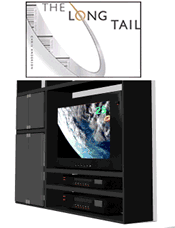 A few years back, you may remember a controversial prediction in Business Week heralding the death of the 30-second TV commercial. While new media is going nuts, and dominating discussions in board rooms and lunch rooms, the fact is that network television is alive and well.
A few years back, you may remember a controversial prediction in Business Week heralding the death of the 30-second TV commercial. While new media is going nuts, and dominating discussions in board rooms and lunch rooms, the fact is that network television is alive and well.
One of the most impactful books to be written about new media is Chris Anderson’s The Long Tail, which suggests that big hits are being replaced by smaller, lesser known titles and shows. This helps to explain how iTunes and Pandora, for example, are turning music lovers onto independent bands, and away from mass appeal acts like Nickelback or Mariah Carey. Or how Netflix and Amazon have driven rentals and sales for more obscure movies. As we know, CD sales are way off, as is box office receipts for former "blockbuster hits."
And yet, television continues to crank out mass appeal shows. And even more importantly, they are creating emotional bonds with viewers in ways that most videos on YouTube cannot. If you think about it, someone sends you a link to a hilarious video, you view it, and perhaps you pass it on. Game over.
But if you’re hooked into "Grey’s Anatomy," "American Idol," or "24," the connection is much stronger. You get to work, you talk about it, you go online, you do a little research. In short, you’re hooked. And technology actually is working for network TV. You could make the case that the DVR/TiVo phenomenon has made it easier to keep up-to-date with shows like "Lost" or "24." And the networks are generally doing a great job of creating web-based support material that enhances these shows’ popularity. This has led to consumer-generated fan sites that keep the fires burning.
More and more, consultants like us are recommending that morning shows tune into big TV shows, TiVo them, and talk about them the "morning after." This is what people are talking about, and DJs that can add to the enjoyment are tapping into mass appeal tastes. But where are OUR innovations, our hot new features, our risk-taking concepts that capture our audience’s imaginations?
These shows aren’t happening by accident. It’s hard to make hit TV, just as it’s hard to develop and grow great morning shows. But radio isn’t going to win the content war by continuing to test and retest music libraries and fine-tune Selector or MusicMaster databases to the exclusion of bona fide personality development.
Let’s face it – to launch and nurture a new morning show costs a lot of money, R&D, and time. The syndication model will only take us so far, and Howard Stern’s exodus to satellite radio has created a vacuum that we have not successfully filled. There are better jukeboxes out there than the ones we can create. But when it comes to Tom Barnard, Drew & Mike, B.J. Shea, Brother Wease, and Bob & Brian, they are exclusive, proprietary and compelling, not to mention local.
Given where our technology-fueled pop culture is heading, what choice does radio have? Where are the new shows, the new personalities, the new concepts that will connect listeners, create communities, and develop habit-forming content? In our rush to add units, cut staff, and make budget, these are questions we’d better start answering. The TV model can work for us, but it’s not going to happen by osmosis.
- Media And Technology In 2025: Believe It Or Not! - April 18, 2025
- In Radio, You Just Never Know - April 17, 2025
- The Secret To Making A Great Podcast (And Great Radio) - April 16, 2025




Leave a Reply